Renewable Energy Implementation in UK Organizations: A Report
VerifiedAdded on 2024/05/30
|27
|7030
|234
Report
AI Summary
This research investigates the adoption and impact of renewable energy sources within UK organizations, highlighting the shift from non-renewable resources due to increasing industrial development and environmental concerns. The report assesses the benefits, challenges, and drivers of renewable energy implementation, emphasizing the need for consumer awareness and sustainable development. It analyzes how UK organizations are integrating renewable energy into their manufacturing and production processes, examining the role of government policies, technological advancements, and economic factors. The study also addresses the importance of blending sustainable practices with economic gains and explores future implications for industrial operations and marketing strategies, ultimately aiming to promote the use of renewable energy to secure a healthier future for generations to come. Desklib provides access to this and other solved assignments for students.
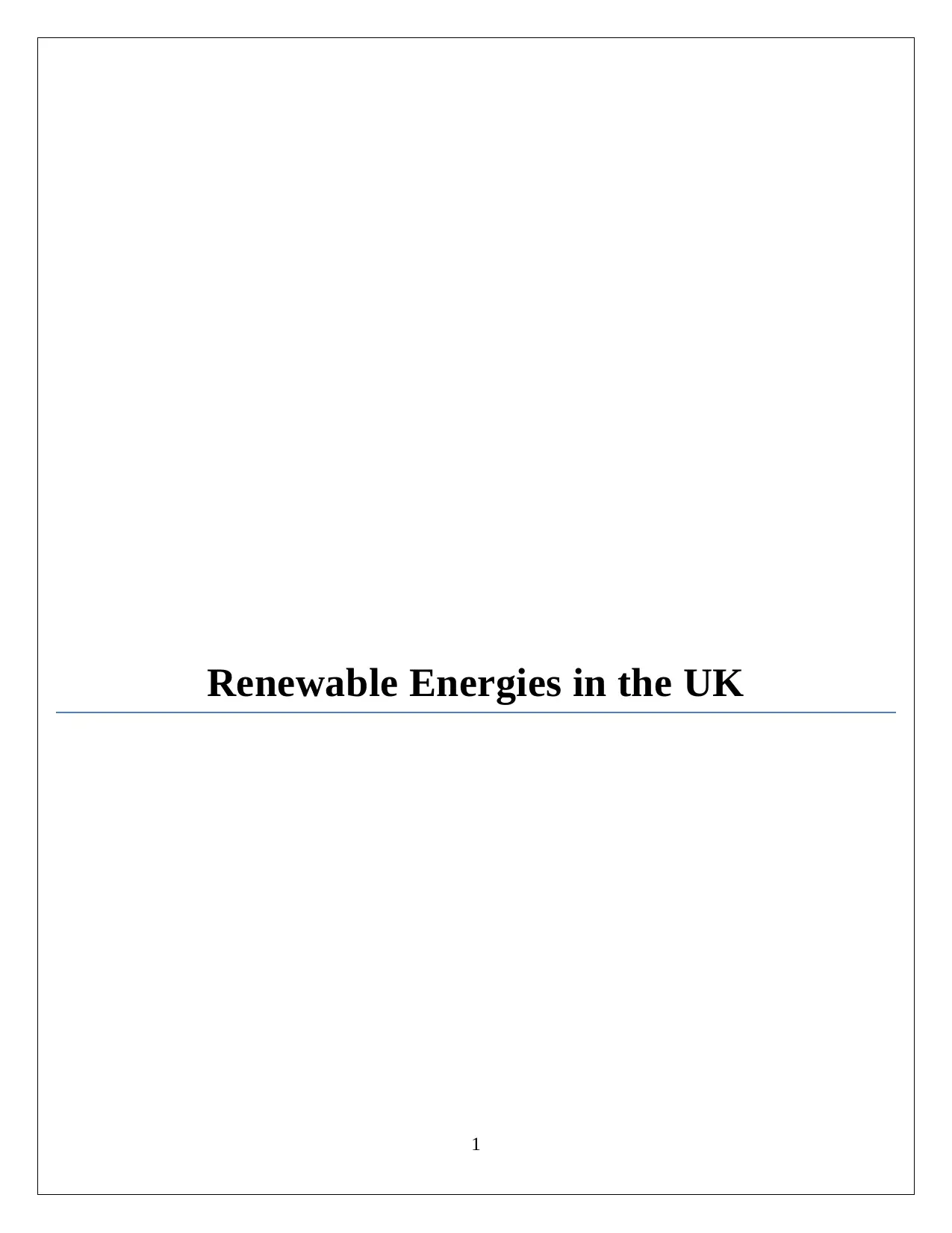
Renewable Energies in the UK
1
1
Paraphrase This Document
Need a fresh take? Get an instant paraphrase of this document with our AI Paraphraser
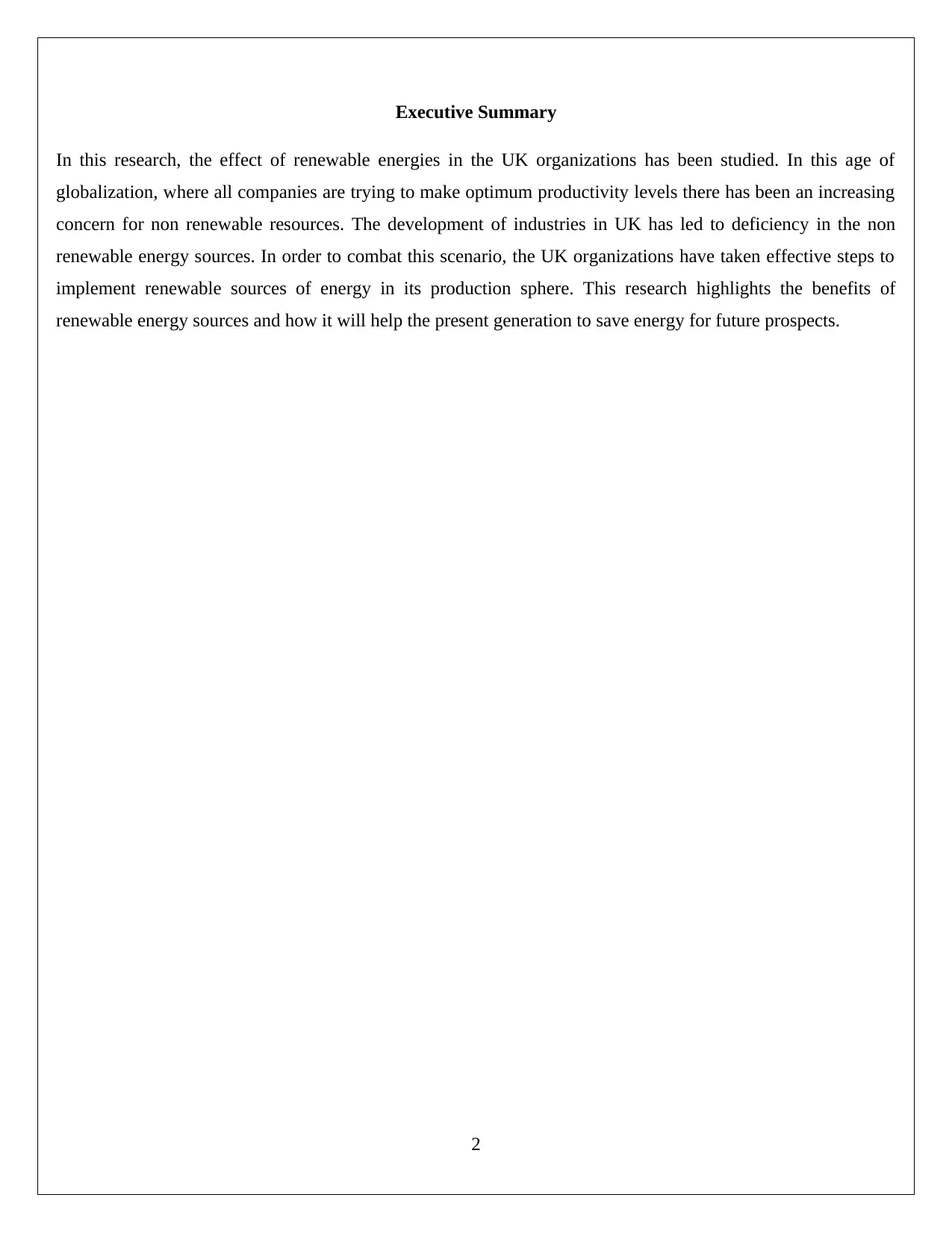
Executive Summary
In this research, the effect of renewable energies in the UK organizations has been studied. In this age of
globalization, where all companies are trying to make optimum productivity levels there has been an increasing
concern for non renewable resources. The development of industries in UK has led to deficiency in the non
renewable energy sources. In order to combat this scenario, the UK organizations have taken effective steps to
implement renewable sources of energy in its production sphere. This research highlights the benefits of
renewable energy sources and how it will help the present generation to save energy for future prospects.
2
In this research, the effect of renewable energies in the UK organizations has been studied. In this age of
globalization, where all companies are trying to make optimum productivity levels there has been an increasing
concern for non renewable resources. The development of industries in UK has led to deficiency in the non
renewable energy sources. In order to combat this scenario, the UK organizations have taken effective steps to
implement renewable sources of energy in its production sphere. This research highlights the benefits of
renewable energy sources and how it will help the present generation to save energy for future prospects.
2
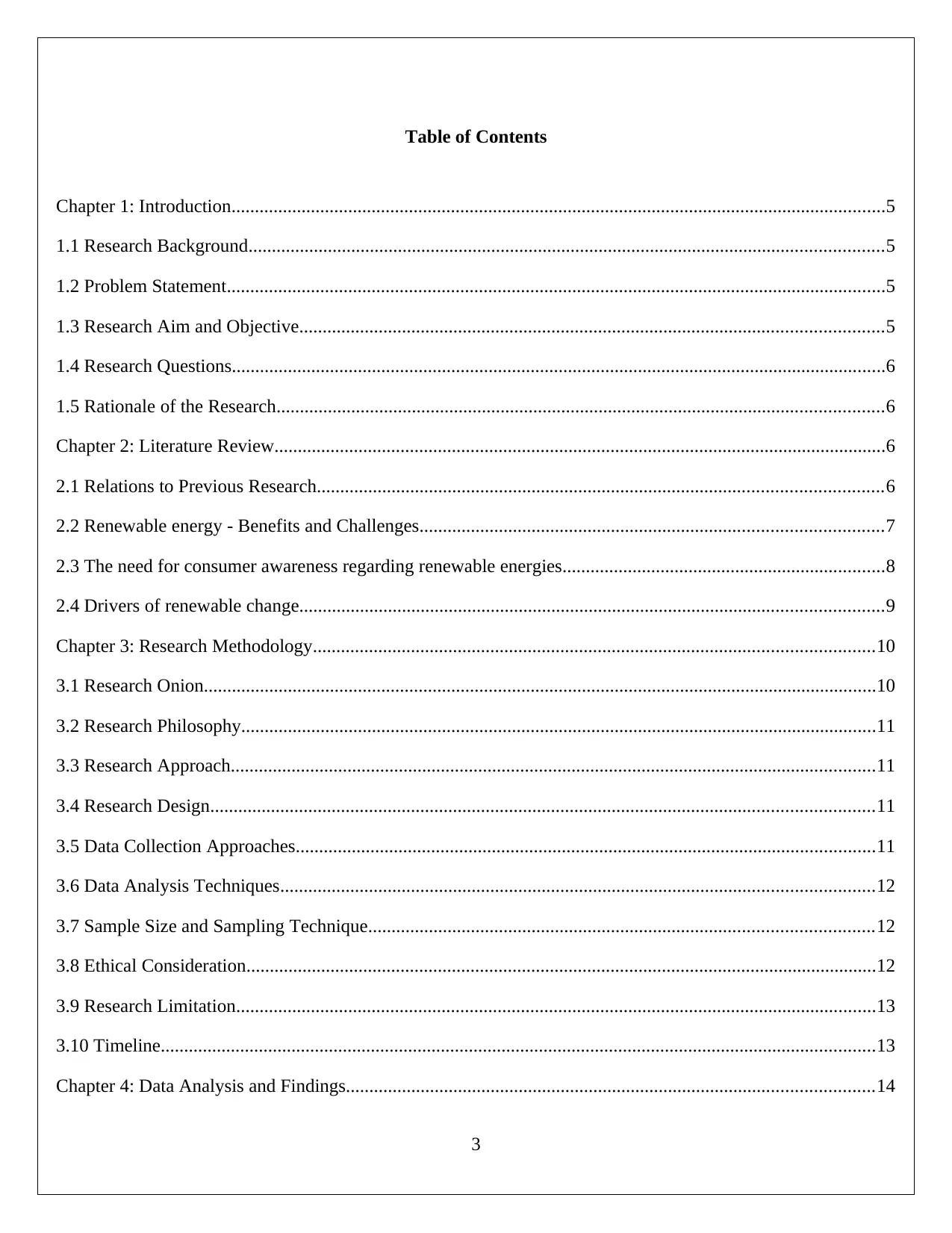
Table of Contents
Chapter 1: Introduction............................................................................................................................................5
1.1 Research Background........................................................................................................................................5
1.2 Problem Statement.............................................................................................................................................5
1.3 Research Aim and Objective.............................................................................................................................5
1.4 Research Questions............................................................................................................................................6
1.5 Rationale of the Research..................................................................................................................................6
Chapter 2: Literature Review...................................................................................................................................6
2.1 Relations to Previous Research.........................................................................................................................6
2.2 Renewable energy - Benefits and Challenges...................................................................................................7
2.3 The need for consumer awareness regarding renewable energies.....................................................................8
2.4 Drivers of renewable change.............................................................................................................................9
Chapter 3: Research Methodology........................................................................................................................10
3.1 Research Onion................................................................................................................................................10
3.2 Research Philosophy........................................................................................................................................11
3.3 Research Approach..........................................................................................................................................11
3.4 Research Design..............................................................................................................................................11
3.5 Data Collection Approaches............................................................................................................................11
3.6 Data Analysis Techniques...............................................................................................................................12
3.7 Sample Size and Sampling Technique............................................................................................................12
3.8 Ethical Consideration.......................................................................................................................................12
3.9 Research Limitation.........................................................................................................................................13
3.10 Timeline.........................................................................................................................................................13
Chapter 4: Data Analysis and Findings.................................................................................................................14
3
Chapter 1: Introduction............................................................................................................................................5
1.1 Research Background........................................................................................................................................5
1.2 Problem Statement.............................................................................................................................................5
1.3 Research Aim and Objective.............................................................................................................................5
1.4 Research Questions............................................................................................................................................6
1.5 Rationale of the Research..................................................................................................................................6
Chapter 2: Literature Review...................................................................................................................................6
2.1 Relations to Previous Research.........................................................................................................................6
2.2 Renewable energy - Benefits and Challenges...................................................................................................7
2.3 The need for consumer awareness regarding renewable energies.....................................................................8
2.4 Drivers of renewable change.............................................................................................................................9
Chapter 3: Research Methodology........................................................................................................................10
3.1 Research Onion................................................................................................................................................10
3.2 Research Philosophy........................................................................................................................................11
3.3 Research Approach..........................................................................................................................................11
3.4 Research Design..............................................................................................................................................11
3.5 Data Collection Approaches............................................................................................................................11
3.6 Data Analysis Techniques...............................................................................................................................12
3.7 Sample Size and Sampling Technique............................................................................................................12
3.8 Ethical Consideration.......................................................................................................................................12
3.9 Research Limitation.........................................................................................................................................13
3.10 Timeline.........................................................................................................................................................13
Chapter 4: Data Analysis and Findings.................................................................................................................14
3
⊘ This is a preview!⊘
Do you want full access?
Subscribe today to unlock all pages.

Trusted by 1+ million students worldwide
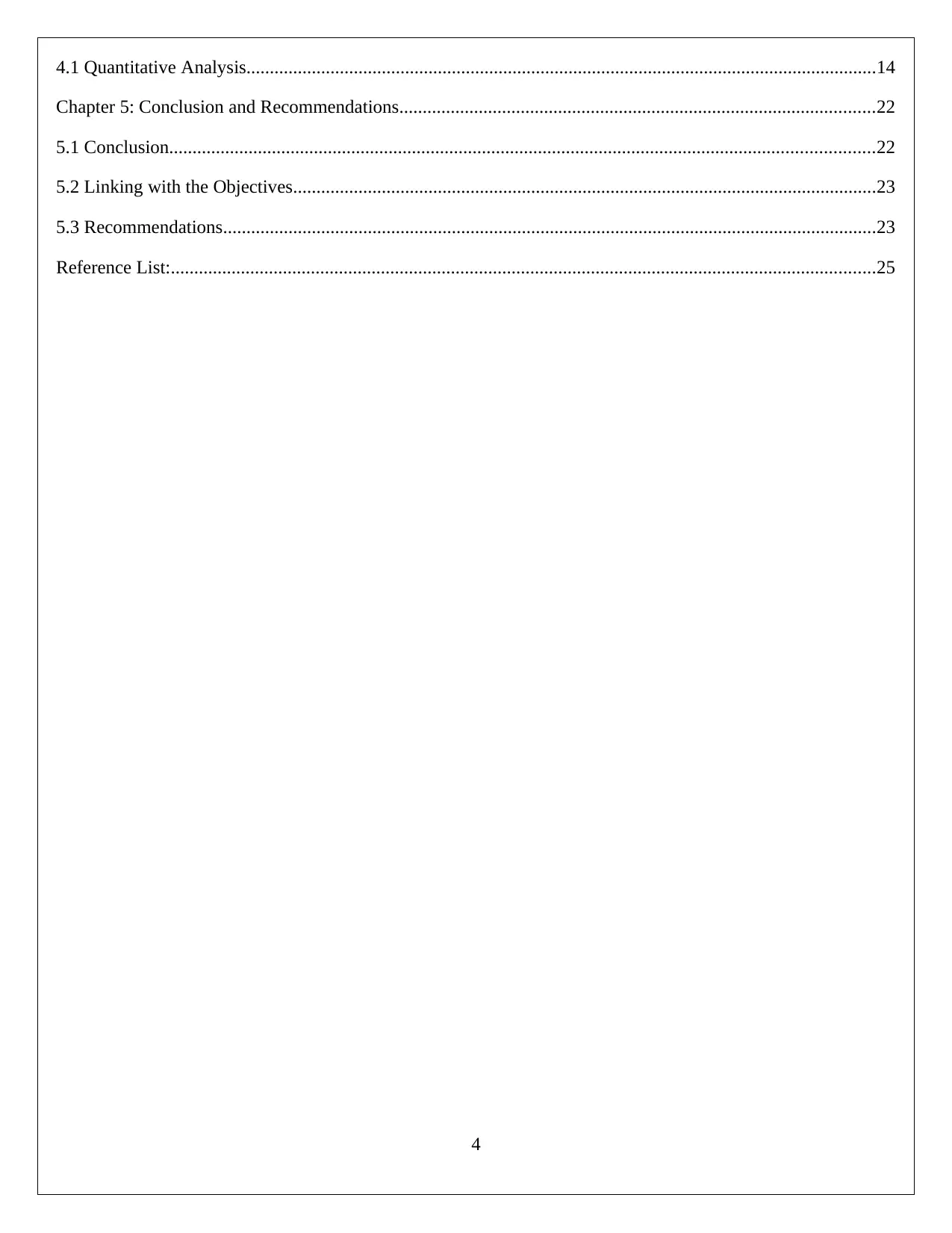
4.1 Quantitative Analysis.......................................................................................................................................14
Chapter 5: Conclusion and Recommendations......................................................................................................22
5.1 Conclusion.......................................................................................................................................................22
5.2 Linking with the Objectives.............................................................................................................................23
5.3 Recommendations............................................................................................................................................23
Reference List:.......................................................................................................................................................25
4
Chapter 5: Conclusion and Recommendations......................................................................................................22
5.1 Conclusion.......................................................................................................................................................22
5.2 Linking with the Objectives.............................................................................................................................23
5.3 Recommendations............................................................................................................................................23
Reference List:.......................................................................................................................................................25
4
Paraphrase This Document
Need a fresh take? Get an instant paraphrase of this document with our AI Paraphraser
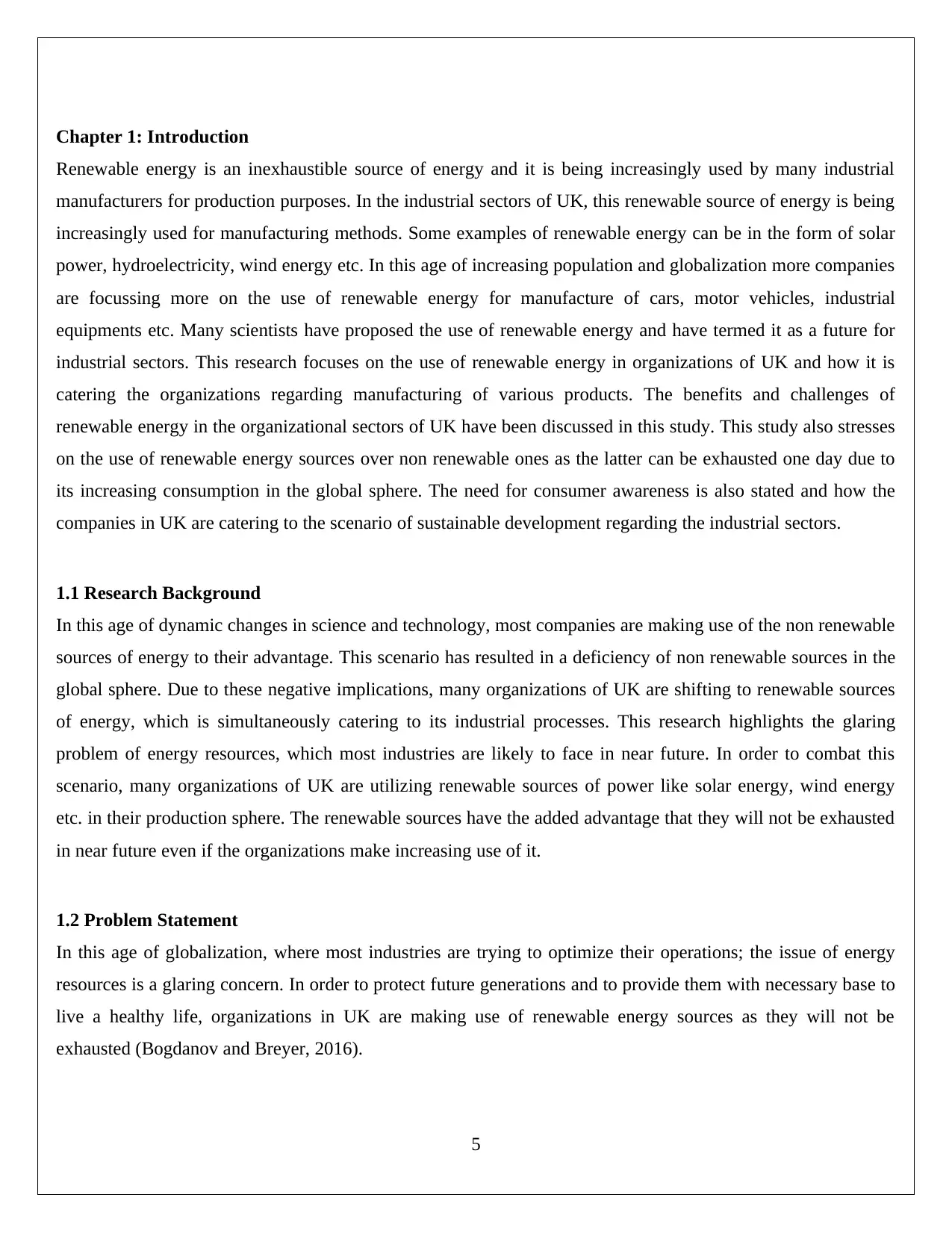
Chapter 1: Introduction
Renewable energy is an inexhaustible source of energy and it is being increasingly used by many industrial
manufacturers for production purposes. In the industrial sectors of UK, this renewable source of energy is being
increasingly used for manufacturing methods. Some examples of renewable energy can be in the form of solar
power, hydroelectricity, wind energy etc. In this age of increasing population and globalization more companies
are focussing more on the use of renewable energy for manufacture of cars, motor vehicles, industrial
equipments etc. Many scientists have proposed the use of renewable energy and have termed it as a future for
industrial sectors. This research focuses on the use of renewable energy in organizations of UK and how it is
catering the organizations regarding manufacturing of various products. The benefits and challenges of
renewable energy in the organizational sectors of UK have been discussed in this study. This study also stresses
on the use of renewable energy sources over non renewable ones as the latter can be exhausted one day due to
its increasing consumption in the global sphere. The need for consumer awareness is also stated and how the
companies in UK are catering to the scenario of sustainable development regarding the industrial sectors.
1.1 Research Background
In this age of dynamic changes in science and technology, most companies are making use of the non renewable
sources of energy to their advantage. This scenario has resulted in a deficiency of non renewable sources in the
global sphere. Due to these negative implications, many organizations of UK are shifting to renewable sources
of energy, which is simultaneously catering to its industrial processes. This research highlights the glaring
problem of energy resources, which most industries are likely to face in near future. In order to combat this
scenario, many organizations of UK are utilizing renewable sources of power like solar energy, wind energy
etc. in their production sphere. The renewable sources have the added advantage that they will not be exhausted
in near future even if the organizations make increasing use of it.
1.2 Problem Statement
In this age of globalization, where most industries are trying to optimize their operations; the issue of energy
resources is a glaring concern. In order to protect future generations and to provide them with necessary base to
live a healthy life, organizations in UK are making use of renewable energy sources as they will not be
exhausted (Bogdanov and Breyer, 2016).
5
Renewable energy is an inexhaustible source of energy and it is being increasingly used by many industrial
manufacturers for production purposes. In the industrial sectors of UK, this renewable source of energy is being
increasingly used for manufacturing methods. Some examples of renewable energy can be in the form of solar
power, hydroelectricity, wind energy etc. In this age of increasing population and globalization more companies
are focussing more on the use of renewable energy for manufacture of cars, motor vehicles, industrial
equipments etc. Many scientists have proposed the use of renewable energy and have termed it as a future for
industrial sectors. This research focuses on the use of renewable energy in organizations of UK and how it is
catering the organizations regarding manufacturing of various products. The benefits and challenges of
renewable energy in the organizational sectors of UK have been discussed in this study. This study also stresses
on the use of renewable energy sources over non renewable ones as the latter can be exhausted one day due to
its increasing consumption in the global sphere. The need for consumer awareness is also stated and how the
companies in UK are catering to the scenario of sustainable development regarding the industrial sectors.
1.1 Research Background
In this age of dynamic changes in science and technology, most companies are making use of the non renewable
sources of energy to their advantage. This scenario has resulted in a deficiency of non renewable sources in the
global sphere. Due to these negative implications, many organizations of UK are shifting to renewable sources
of energy, which is simultaneously catering to its industrial processes. This research highlights the glaring
problem of energy resources, which most industries are likely to face in near future. In order to combat this
scenario, many organizations of UK are utilizing renewable sources of power like solar energy, wind energy
etc. in their production sphere. The renewable sources have the added advantage that they will not be exhausted
in near future even if the organizations make increasing use of it.
1.2 Problem Statement
In this age of globalization, where most industries are trying to optimize their operations; the issue of energy
resources is a glaring concern. In order to protect future generations and to provide them with necessary base to
live a healthy life, organizations in UK are making use of renewable energy sources as they will not be
exhausted (Bogdanov and Breyer, 2016).
5
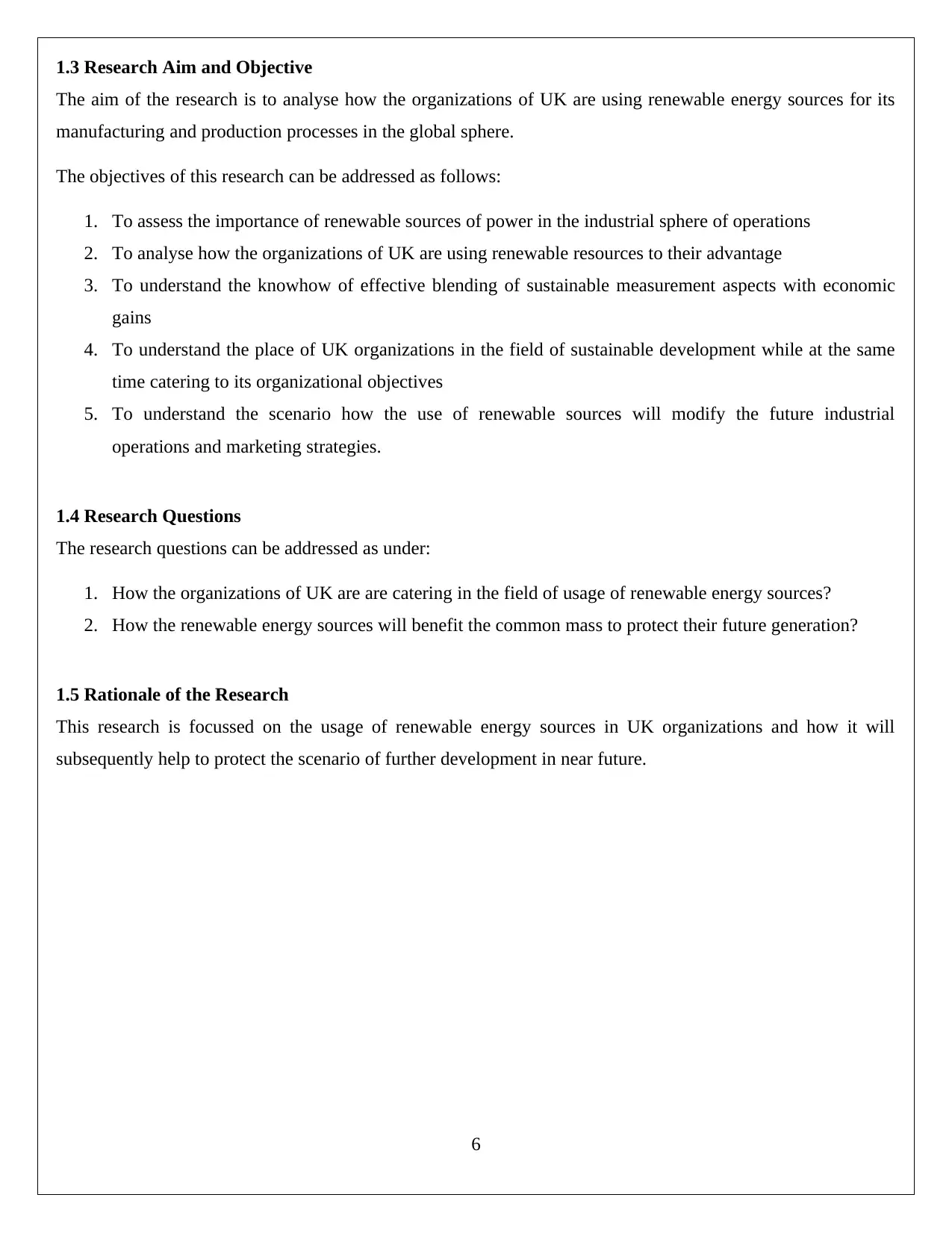
1.3 Research Aim and Objective
The aim of the research is to analyse how the organizations of UK are using renewable energy sources for its
manufacturing and production processes in the global sphere.
The objectives of this research can be addressed as follows:
1. To assess the importance of renewable sources of power in the industrial sphere of operations
2. To analyse how the organizations of UK are using renewable resources to their advantage
3. To understand the knowhow of effective blending of sustainable measurement aspects with economic
gains
4. To understand the place of UK organizations in the field of sustainable development while at the same
time catering to its organizational objectives
5. To understand the scenario how the use of renewable sources will modify the future industrial
operations and marketing strategies.
1.4 Research Questions
The research questions can be addressed as under:
1. How the organizations of UK are are catering in the field of usage of renewable energy sources?
2. How the renewable energy sources will benefit the common mass to protect their future generation?
1.5 Rationale of the Research
This research is focussed on the usage of renewable energy sources in UK organizations and how it will
subsequently help to protect the scenario of further development in near future.
6
The aim of the research is to analyse how the organizations of UK are using renewable energy sources for its
manufacturing and production processes in the global sphere.
The objectives of this research can be addressed as follows:
1. To assess the importance of renewable sources of power in the industrial sphere of operations
2. To analyse how the organizations of UK are using renewable resources to their advantage
3. To understand the knowhow of effective blending of sustainable measurement aspects with economic
gains
4. To understand the place of UK organizations in the field of sustainable development while at the same
time catering to its organizational objectives
5. To understand the scenario how the use of renewable sources will modify the future industrial
operations and marketing strategies.
1.4 Research Questions
The research questions can be addressed as under:
1. How the organizations of UK are are catering in the field of usage of renewable energy sources?
2. How the renewable energy sources will benefit the common mass to protect their future generation?
1.5 Rationale of the Research
This research is focussed on the usage of renewable energy sources in UK organizations and how it will
subsequently help to protect the scenario of further development in near future.
6
⊘ This is a preview!⊘
Do you want full access?
Subscribe today to unlock all pages.

Trusted by 1+ million students worldwide
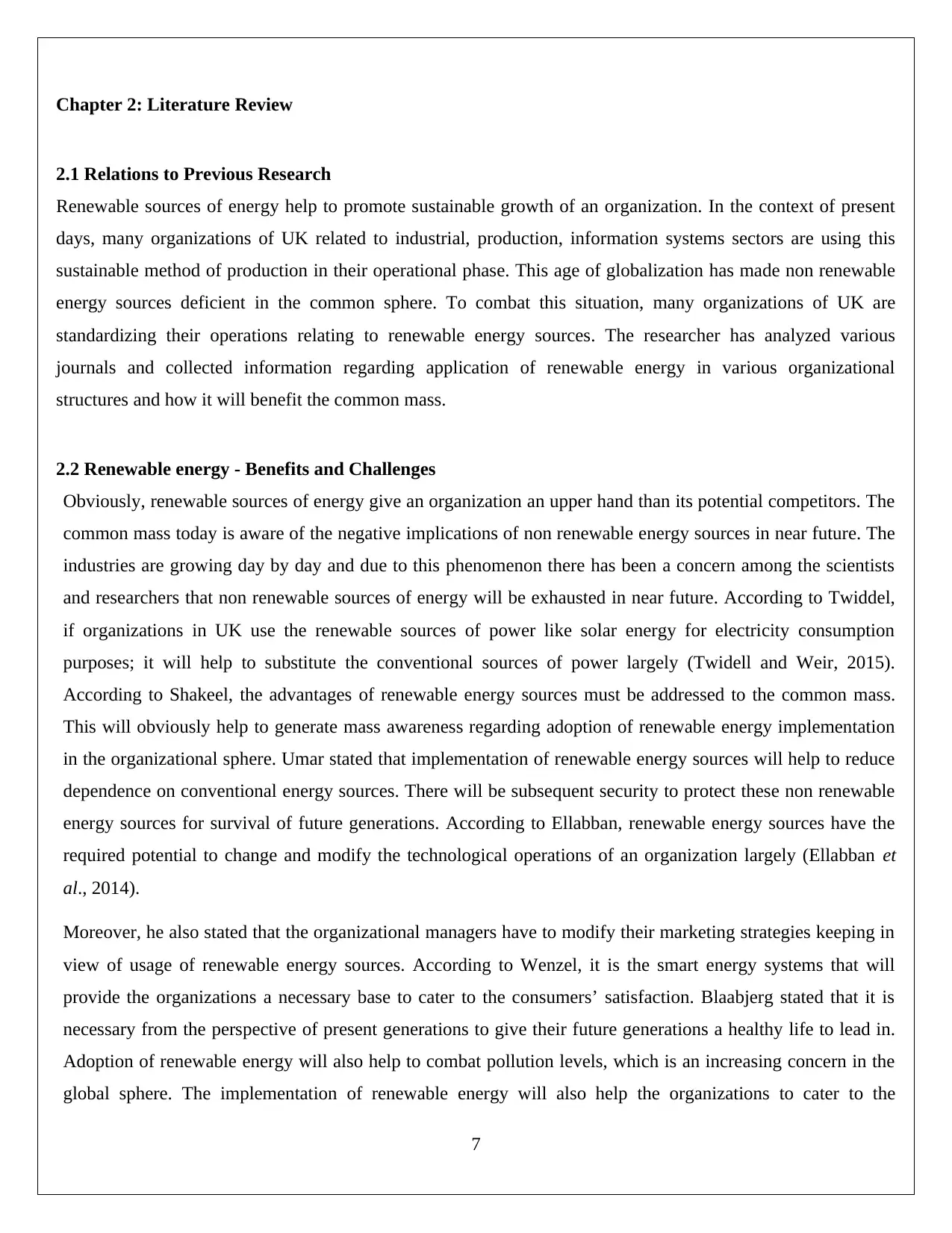
Chapter 2: Literature Review
2.1 Relations to Previous Research
Renewable sources of energy help to promote sustainable growth of an organization. In the context of present
days, many organizations of UK related to industrial, production, information systems sectors are using this
sustainable method of production in their operational phase. This age of globalization has made non renewable
energy sources deficient in the common sphere. To combat this situation, many organizations of UK are
standardizing their operations relating to renewable energy sources. The researcher has analyzed various
journals and collected information regarding application of renewable energy in various organizational
structures and how it will benefit the common mass.
2.2 Renewable energy - Benefits and Challenges
Obviously, renewable sources of energy give an organization an upper hand than its potential competitors. The
common mass today is aware of the negative implications of non renewable energy sources in near future. The
industries are growing day by day and due to this phenomenon there has been a concern among the scientists
and researchers that non renewable sources of energy will be exhausted in near future. According to Twiddel,
if organizations in UK use the renewable sources of power like solar energy for electricity consumption
purposes; it will help to substitute the conventional sources of power largely (Twidell and Weir, 2015).
According to Shakeel, the advantages of renewable energy sources must be addressed to the common mass.
This will obviously help to generate mass awareness regarding adoption of renewable energy implementation
in the organizational sphere. Umar stated that implementation of renewable energy sources will help to reduce
dependence on conventional energy sources. There will be subsequent security to protect these non renewable
energy sources for survival of future generations. According to Ellabban, renewable energy sources have the
required potential to change and modify the technological operations of an organization largely (Ellabban et
al., 2014).
Moreover, he also stated that the organizational managers have to modify their marketing strategies keeping in
view of usage of renewable energy sources. According to Wenzel, it is the smart energy systems that will
provide the organizations a necessary base to cater to the consumers’ satisfaction. Blaabjerg stated that it is
necessary from the perspective of present generations to give their future generations a healthy life to lead in.
Adoption of renewable energy will also help to combat pollution levels, which is an increasing concern in the
global sphere. The implementation of renewable energy will also help the organizations to cater to the
7
2.1 Relations to Previous Research
Renewable sources of energy help to promote sustainable growth of an organization. In the context of present
days, many organizations of UK related to industrial, production, information systems sectors are using this
sustainable method of production in their operational phase. This age of globalization has made non renewable
energy sources deficient in the common sphere. To combat this situation, many organizations of UK are
standardizing their operations relating to renewable energy sources. The researcher has analyzed various
journals and collected information regarding application of renewable energy in various organizational
structures and how it will benefit the common mass.
2.2 Renewable energy - Benefits and Challenges
Obviously, renewable sources of energy give an organization an upper hand than its potential competitors. The
common mass today is aware of the negative implications of non renewable energy sources in near future. The
industries are growing day by day and due to this phenomenon there has been a concern among the scientists
and researchers that non renewable sources of energy will be exhausted in near future. According to Twiddel,
if organizations in UK use the renewable sources of power like solar energy for electricity consumption
purposes; it will help to substitute the conventional sources of power largely (Twidell and Weir, 2015).
According to Shakeel, the advantages of renewable energy sources must be addressed to the common mass.
This will obviously help to generate mass awareness regarding adoption of renewable energy implementation
in the organizational sphere. Umar stated that implementation of renewable energy sources will help to reduce
dependence on conventional energy sources. There will be subsequent security to protect these non renewable
energy sources for survival of future generations. According to Ellabban, renewable energy sources have the
required potential to change and modify the technological operations of an organization largely (Ellabban et
al., 2014).
Moreover, he also stated that the organizational managers have to modify their marketing strategies keeping in
view of usage of renewable energy sources. According to Wenzel, it is the smart energy systems that will
provide the organizations a necessary base to cater to the consumers’ satisfaction. Blaabjerg stated that it is
necessary from the perspective of present generations to give their future generations a healthy life to lead in.
Adoption of renewable energy will also help to combat pollution levels, which is an increasing concern in the
global sphere. The implementation of renewable energy will also help the organizations to cater to the
7
Paraphrase This Document
Need a fresh take? Get an instant paraphrase of this document with our AI Paraphraser
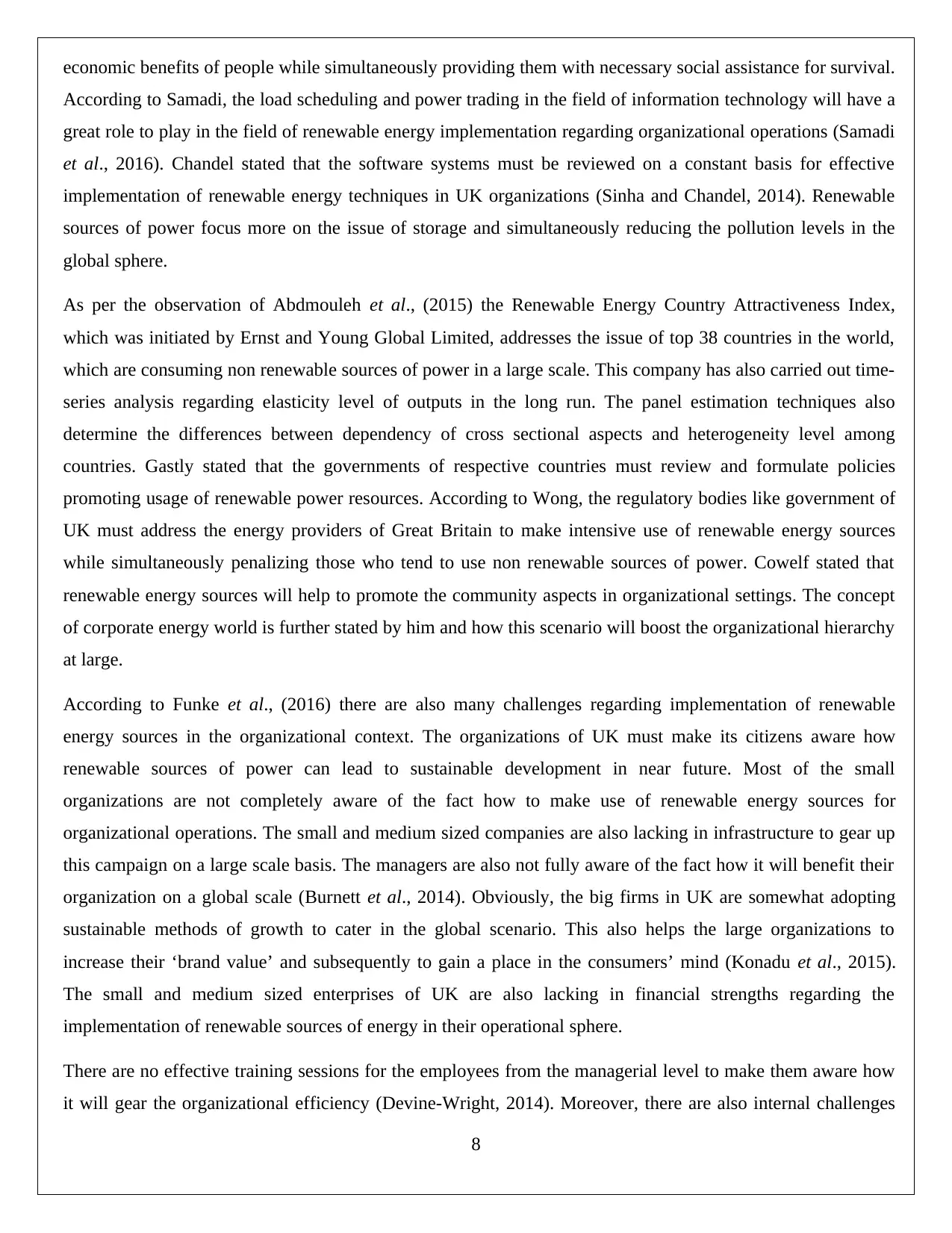
economic benefits of people while simultaneously providing them with necessary social assistance for survival.
According to Samadi, the load scheduling and power trading in the field of information technology will have a
great role to play in the field of renewable energy implementation regarding organizational operations (Samadi
et al., 2016). Chandel stated that the software systems must be reviewed on a constant basis for effective
implementation of renewable energy techniques in UK organizations (Sinha and Chandel, 2014). Renewable
sources of power focus more on the issue of storage and simultaneously reducing the pollution levels in the
global sphere.
As per the observation of Abdmouleh et al., (2015) the Renewable Energy Country Attractiveness Index,
which was initiated by Ernst and Young Global Limited, addresses the issue of top 38 countries in the world,
which are consuming non renewable sources of power in a large scale. This company has also carried out time-
series analysis regarding elasticity level of outputs in the long run. The panel estimation techniques also
determine the differences between dependency of cross sectional aspects and heterogeneity level among
countries. Gastly stated that the governments of respective countries must review and formulate policies
promoting usage of renewable power resources. According to Wong, the regulatory bodies like government of
UK must address the energy providers of Great Britain to make intensive use of renewable energy sources
while simultaneously penalizing those who tend to use non renewable sources of power. Cowelf stated that
renewable energy sources will help to promote the community aspects in organizational settings. The concept
of corporate energy world is further stated by him and how this scenario will boost the organizational hierarchy
at large.
According to Funke et al., (2016) there are also many challenges regarding implementation of renewable
energy sources in the organizational context. The organizations of UK must make its citizens aware how
renewable sources of power can lead to sustainable development in near future. Most of the small
organizations are not completely aware of the fact how to make use of renewable energy sources for
organizational operations. The small and medium sized companies are also lacking in infrastructure to gear up
this campaign on a large scale basis. The managers are also not fully aware of the fact how it will benefit their
organization on a global scale (Burnett et al., 2014). Obviously, the big firms in UK are somewhat adopting
sustainable methods of growth to cater in the global scenario. This also helps the large organizations to
increase their ‘brand value’ and subsequently to gain a place in the consumers’ mind (Konadu et al., 2015).
The small and medium sized enterprises of UK are also lacking in financial strengths regarding the
implementation of renewable sources of energy in their operational sphere.
There are no effective training sessions for the employees from the managerial level to make them aware how
it will gear the organizational efficiency (Devine-Wright, 2014). Moreover, there are also internal challenges
8
According to Samadi, the load scheduling and power trading in the field of information technology will have a
great role to play in the field of renewable energy implementation regarding organizational operations (Samadi
et al., 2016). Chandel stated that the software systems must be reviewed on a constant basis for effective
implementation of renewable energy techniques in UK organizations (Sinha and Chandel, 2014). Renewable
sources of power focus more on the issue of storage and simultaneously reducing the pollution levels in the
global sphere.
As per the observation of Abdmouleh et al., (2015) the Renewable Energy Country Attractiveness Index,
which was initiated by Ernst and Young Global Limited, addresses the issue of top 38 countries in the world,
which are consuming non renewable sources of power in a large scale. This company has also carried out time-
series analysis regarding elasticity level of outputs in the long run. The panel estimation techniques also
determine the differences between dependency of cross sectional aspects and heterogeneity level among
countries. Gastly stated that the governments of respective countries must review and formulate policies
promoting usage of renewable power resources. According to Wong, the regulatory bodies like government of
UK must address the energy providers of Great Britain to make intensive use of renewable energy sources
while simultaneously penalizing those who tend to use non renewable sources of power. Cowelf stated that
renewable energy sources will help to promote the community aspects in organizational settings. The concept
of corporate energy world is further stated by him and how this scenario will boost the organizational hierarchy
at large.
According to Funke et al., (2016) there are also many challenges regarding implementation of renewable
energy sources in the organizational context. The organizations of UK must make its citizens aware how
renewable sources of power can lead to sustainable development in near future. Most of the small
organizations are not completely aware of the fact how to make use of renewable energy sources for
organizational operations. The small and medium sized companies are also lacking in infrastructure to gear up
this campaign on a large scale basis. The managers are also not fully aware of the fact how it will benefit their
organization on a global scale (Burnett et al., 2014). Obviously, the big firms in UK are somewhat adopting
sustainable methods of growth to cater in the global scenario. This also helps the large organizations to
increase their ‘brand value’ and subsequently to gain a place in the consumers’ mind (Konadu et al., 2015).
The small and medium sized enterprises of UK are also lacking in financial strengths regarding the
implementation of renewable sources of energy in their operational sphere.
There are no effective training sessions for the employees from the managerial level to make them aware how
it will gear the organizational efficiency (Devine-Wright, 2014). Moreover, there are also internal challenges
8
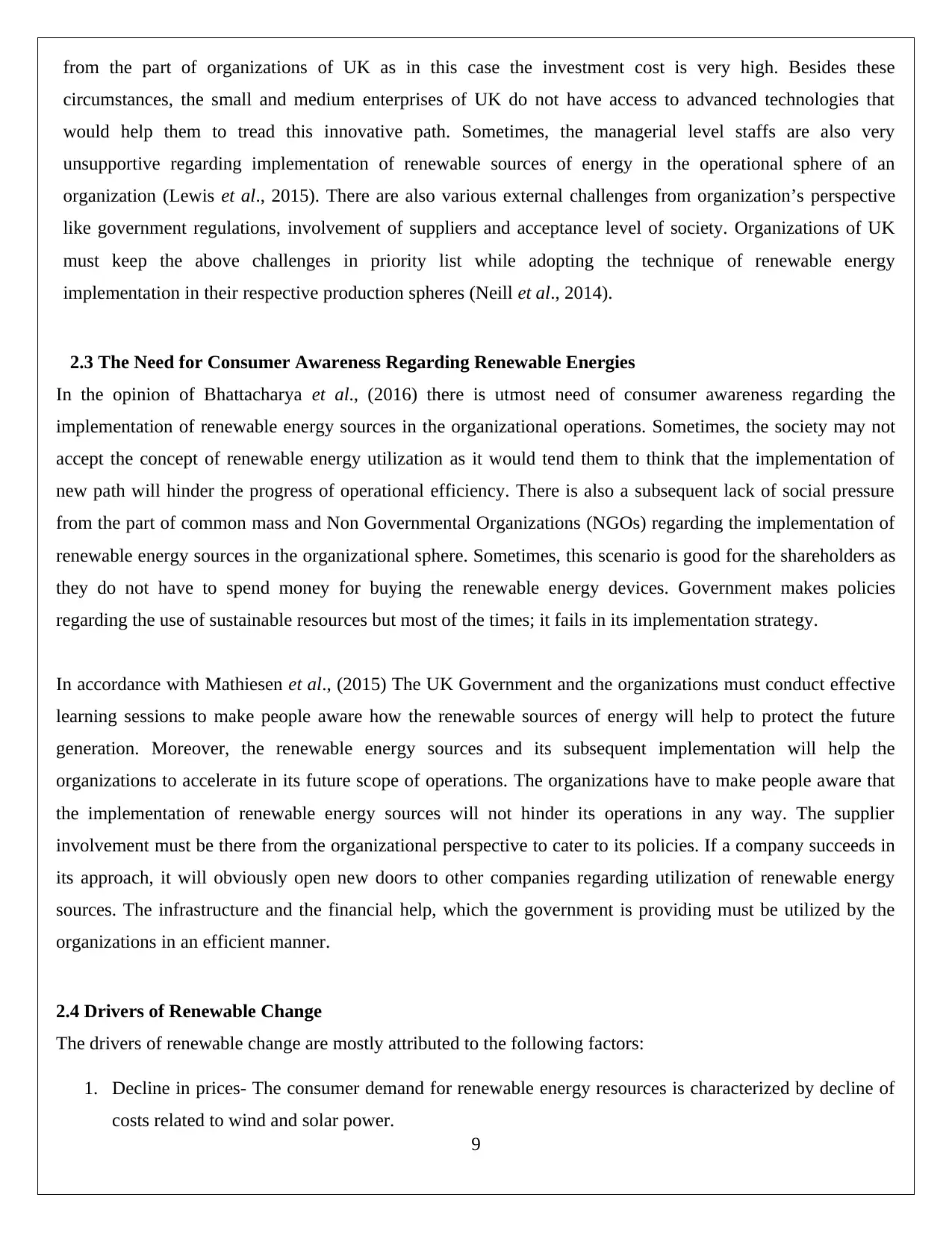
from the part of organizations of UK as in this case the investment cost is very high. Besides these
circumstances, the small and medium enterprises of UK do not have access to advanced technologies that
would help them to tread this innovative path. Sometimes, the managerial level staffs are also very
unsupportive regarding implementation of renewable sources of energy in the operational sphere of an
organization (Lewis et al., 2015). There are also various external challenges from organization’s perspective
like government regulations, involvement of suppliers and acceptance level of society. Organizations of UK
must keep the above challenges in priority list while adopting the technique of renewable energy
implementation in their respective production spheres (Neill et al., 2014).
2.3 The Need for Consumer Awareness Regarding Renewable Energies
In the opinion of Bhattacharya et al., (2016) there is utmost need of consumer awareness regarding the
implementation of renewable energy sources in the organizational operations. Sometimes, the society may not
accept the concept of renewable energy utilization as it would tend them to think that the implementation of
new path will hinder the progress of operational efficiency. There is also a subsequent lack of social pressure
from the part of common mass and Non Governmental Organizations (NGOs) regarding the implementation of
renewable energy sources in the organizational sphere. Sometimes, this scenario is good for the shareholders as
they do not have to spend money for buying the renewable energy devices. Government makes policies
regarding the use of sustainable resources but most of the times; it fails in its implementation strategy.
In accordance with Mathiesen et al., (2015) The UK Government and the organizations must conduct effective
learning sessions to make people aware how the renewable sources of energy will help to protect the future
generation. Moreover, the renewable energy sources and its subsequent implementation will help the
organizations to accelerate in its future scope of operations. The organizations have to make people aware that
the implementation of renewable energy sources will not hinder its operations in any way. The supplier
involvement must be there from the organizational perspective to cater to its policies. If a company succeeds in
its approach, it will obviously open new doors to other companies regarding utilization of renewable energy
sources. The infrastructure and the financial help, which the government is providing must be utilized by the
organizations in an efficient manner.
2.4 Drivers of Renewable Change
The drivers of renewable change are mostly attributed to the following factors:
1. Decline in prices- The consumer demand for renewable energy resources is characterized by decline of
costs related to wind and solar power.
9
circumstances, the small and medium enterprises of UK do not have access to advanced technologies that
would help them to tread this innovative path. Sometimes, the managerial level staffs are also very
unsupportive regarding implementation of renewable sources of energy in the operational sphere of an
organization (Lewis et al., 2015). There are also various external challenges from organization’s perspective
like government regulations, involvement of suppliers and acceptance level of society. Organizations of UK
must keep the above challenges in priority list while adopting the technique of renewable energy
implementation in their respective production spheres (Neill et al., 2014).
2.3 The Need for Consumer Awareness Regarding Renewable Energies
In the opinion of Bhattacharya et al., (2016) there is utmost need of consumer awareness regarding the
implementation of renewable energy sources in the organizational operations. Sometimes, the society may not
accept the concept of renewable energy utilization as it would tend them to think that the implementation of
new path will hinder the progress of operational efficiency. There is also a subsequent lack of social pressure
from the part of common mass and Non Governmental Organizations (NGOs) regarding the implementation of
renewable energy sources in the organizational sphere. Sometimes, this scenario is good for the shareholders as
they do not have to spend money for buying the renewable energy devices. Government makes policies
regarding the use of sustainable resources but most of the times; it fails in its implementation strategy.
In accordance with Mathiesen et al., (2015) The UK Government and the organizations must conduct effective
learning sessions to make people aware how the renewable sources of energy will help to protect the future
generation. Moreover, the renewable energy sources and its subsequent implementation will help the
organizations to accelerate in its future scope of operations. The organizations have to make people aware that
the implementation of renewable energy sources will not hinder its operations in any way. The supplier
involvement must be there from the organizational perspective to cater to its policies. If a company succeeds in
its approach, it will obviously open new doors to other companies regarding utilization of renewable energy
sources. The infrastructure and the financial help, which the government is providing must be utilized by the
organizations in an efficient manner.
2.4 Drivers of Renewable Change
The drivers of renewable change are mostly attributed to the following factors:
1. Decline in prices- The consumer demand for renewable energy resources is characterized by decline of
costs related to wind and solar power.
9
⊘ This is a preview!⊘
Do you want full access?
Subscribe today to unlock all pages.

Trusted by 1+ million students worldwide
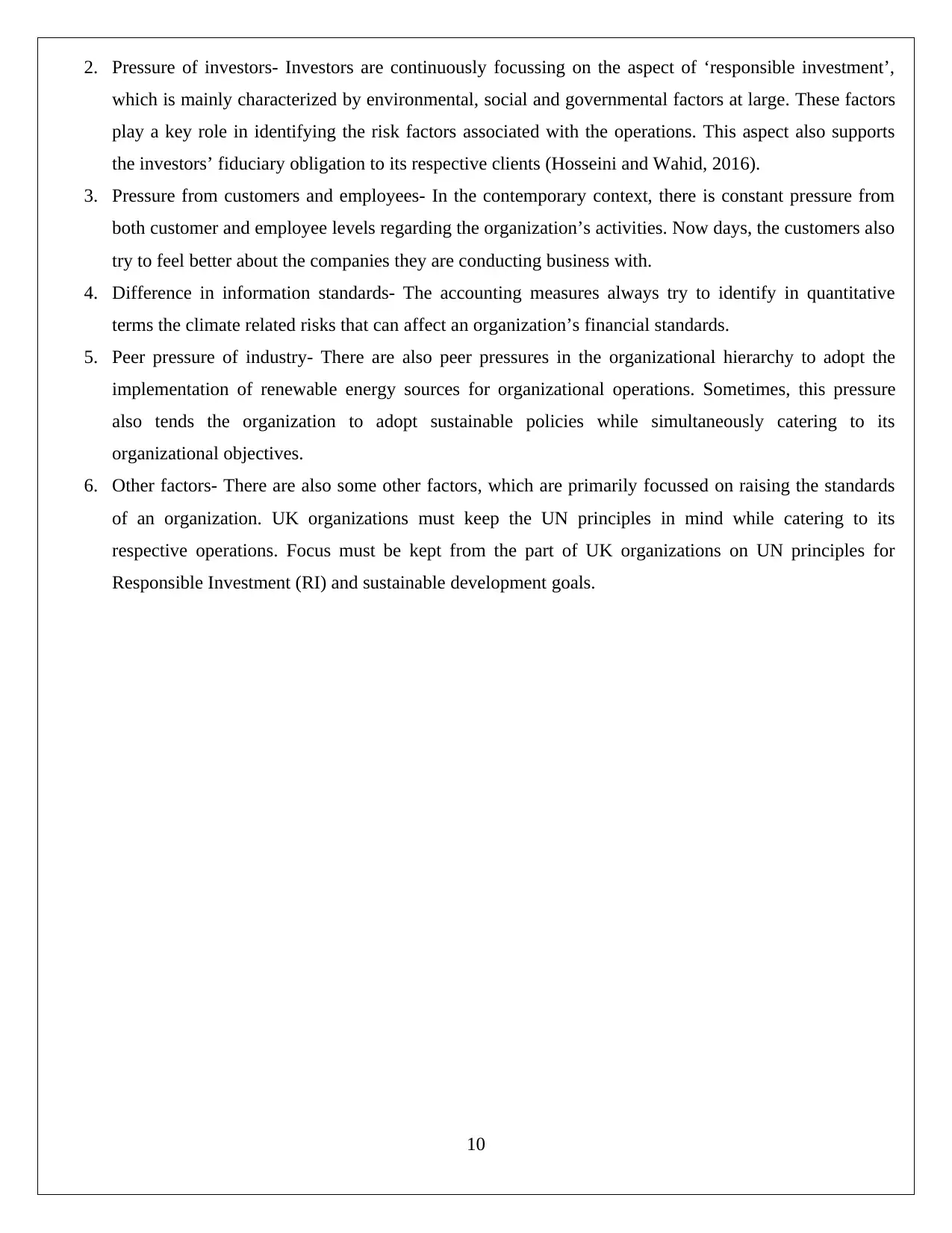
2. Pressure of investors- Investors are continuously focussing on the aspect of ‘responsible investment’,
which is mainly characterized by environmental, social and governmental factors at large. These factors
play a key role in identifying the risk factors associated with the operations. This aspect also supports
the investors’ fiduciary obligation to its respective clients (Hosseini and Wahid, 2016).
3. Pressure from customers and employees- In the contemporary context, there is constant pressure from
both customer and employee levels regarding the organization’s activities. Now days, the customers also
try to feel better about the companies they are conducting business with.
4. Difference in information standards- The accounting measures always try to identify in quantitative
terms the climate related risks that can affect an organization’s financial standards.
5. Peer pressure of industry- There are also peer pressures in the organizational hierarchy to adopt the
implementation of renewable energy sources for organizational operations. Sometimes, this pressure
also tends the organization to adopt sustainable policies while simultaneously catering to its
organizational objectives.
6. Other factors- There are also some other factors, which are primarily focussed on raising the standards
of an organization. UK organizations must keep the UN principles in mind while catering to its
respective operations. Focus must be kept from the part of UK organizations on UN principles for
Responsible Investment (RI) and sustainable development goals.
10
which is mainly characterized by environmental, social and governmental factors at large. These factors
play a key role in identifying the risk factors associated with the operations. This aspect also supports
the investors’ fiduciary obligation to its respective clients (Hosseini and Wahid, 2016).
3. Pressure from customers and employees- In the contemporary context, there is constant pressure from
both customer and employee levels regarding the organization’s activities. Now days, the customers also
try to feel better about the companies they are conducting business with.
4. Difference in information standards- The accounting measures always try to identify in quantitative
terms the climate related risks that can affect an organization’s financial standards.
5. Peer pressure of industry- There are also peer pressures in the organizational hierarchy to adopt the
implementation of renewable energy sources for organizational operations. Sometimes, this pressure
also tends the organization to adopt sustainable policies while simultaneously catering to its
organizational objectives.
6. Other factors- There are also some other factors, which are primarily focussed on raising the standards
of an organization. UK organizations must keep the UN principles in mind while catering to its
respective operations. Focus must be kept from the part of UK organizations on UN principles for
Responsible Investment (RI) and sustainable development goals.
10
Paraphrase This Document
Need a fresh take? Get an instant paraphrase of this document with our AI Paraphraser
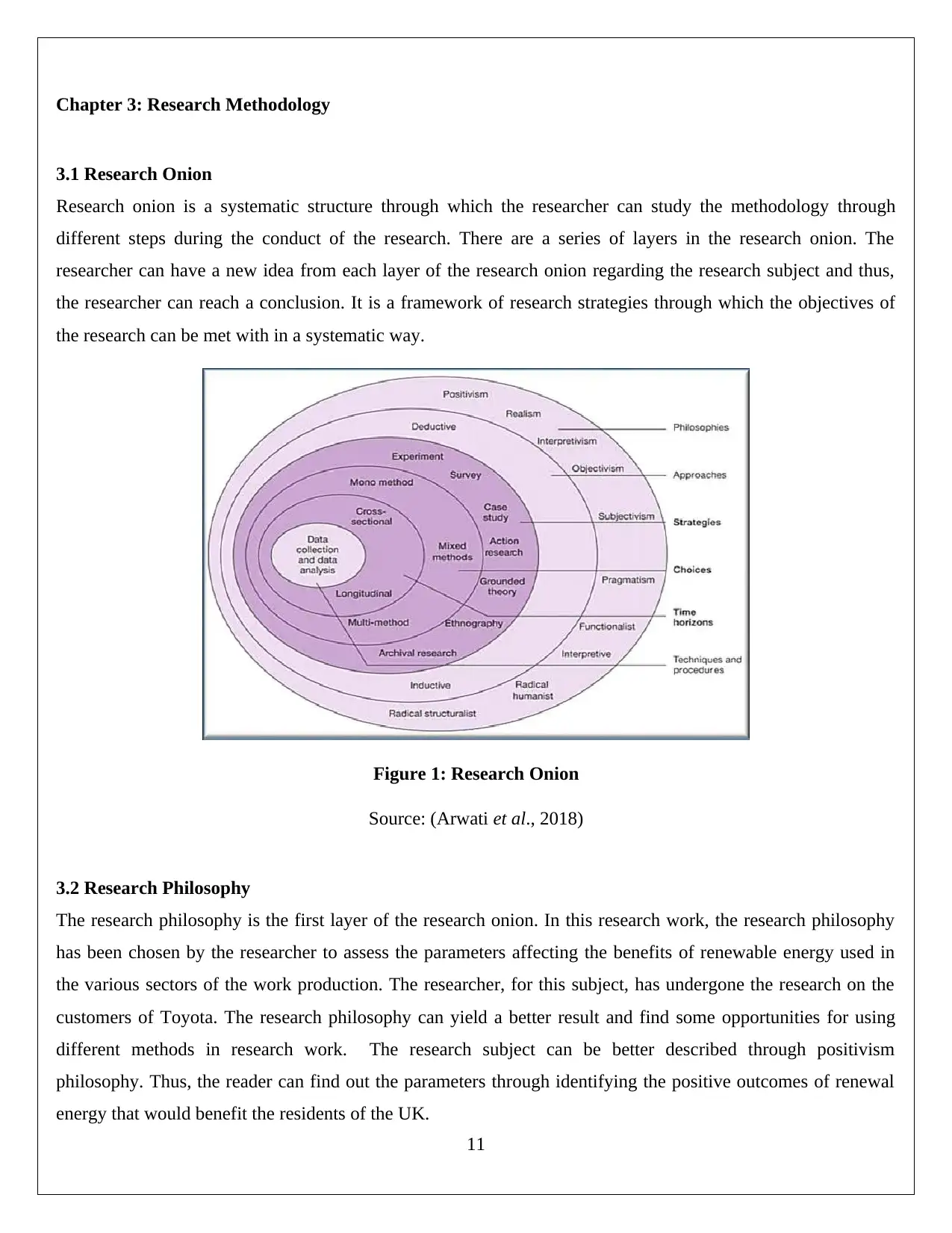
Chapter 3: Research Methodology
3.1 Research Onion
Research onion is a systematic structure through which the researcher can study the methodology through
different steps during the conduct of the research. There are a series of layers in the research onion. The
researcher can have a new idea from each layer of the research onion regarding the research subject and thus,
the researcher can reach a conclusion. It is a framework of research strategies through which the objectives of
the research can be met with in a systematic way.
Figure 1: Research Onion
Source: (Arwati et al., 2018)
3.2 Research Philosophy
The research philosophy is the first layer of the research onion. In this research work, the research philosophy
has been chosen by the researcher to assess the parameters affecting the benefits of renewable energy used in
the various sectors of the work production. The researcher, for this subject, has undergone the research on the
customers of Toyota. The research philosophy can yield a better result and find some opportunities for using
different methods in research work. The research subject can be better described through positivism
philosophy. Thus, the reader can find out the parameters through identifying the positive outcomes of renewal
energy that would benefit the residents of the UK.
11
3.1 Research Onion
Research onion is a systematic structure through which the researcher can study the methodology through
different steps during the conduct of the research. There are a series of layers in the research onion. The
researcher can have a new idea from each layer of the research onion regarding the research subject and thus,
the researcher can reach a conclusion. It is a framework of research strategies through which the objectives of
the research can be met with in a systematic way.
Figure 1: Research Onion
Source: (Arwati et al., 2018)
3.2 Research Philosophy
The research philosophy is the first layer of the research onion. In this research work, the research philosophy
has been chosen by the researcher to assess the parameters affecting the benefits of renewable energy used in
the various sectors of the work production. The researcher, for this subject, has undergone the research on the
customers of Toyota. The research philosophy can yield a better result and find some opportunities for using
different methods in research work. The research subject can be better described through positivism
philosophy. Thus, the reader can find out the parameters through identifying the positive outcomes of renewal
energy that would benefit the residents of the UK.
11
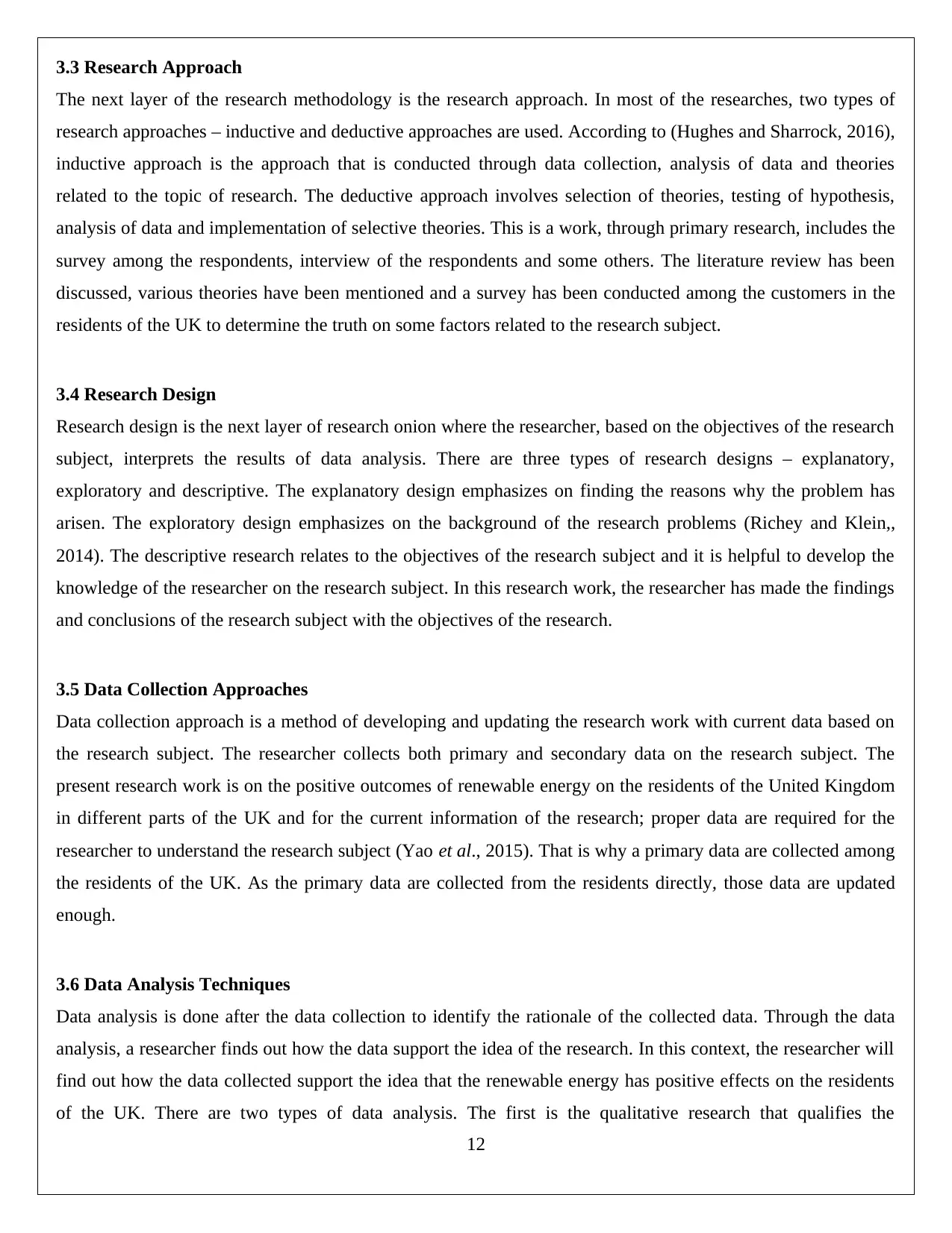
3.3 Research Approach
The next layer of the research methodology is the research approach. In most of the researches, two types of
research approaches – inductive and deductive approaches are used. According to (Hughes and Sharrock, 2016),
inductive approach is the approach that is conducted through data collection, analysis of data and theories
related to the topic of research. The deductive approach involves selection of theories, testing of hypothesis,
analysis of data and implementation of selective theories. This is a work, through primary research, includes the
survey among the respondents, interview of the respondents and some others. The literature review has been
discussed, various theories have been mentioned and a survey has been conducted among the customers in the
residents of the UK to determine the truth on some factors related to the research subject.
3.4 Research Design
Research design is the next layer of research onion where the researcher, based on the objectives of the research
subject, interprets the results of data analysis. There are three types of research designs – explanatory,
exploratory and descriptive. The explanatory design emphasizes on finding the reasons why the problem has
arisen. The exploratory design emphasizes on the background of the research problems (Richey and Klein,,
2014). The descriptive research relates to the objectives of the research subject and it is helpful to develop the
knowledge of the researcher on the research subject. In this research work, the researcher has made the findings
and conclusions of the research subject with the objectives of the research.
3.5 Data Collection Approaches
Data collection approach is a method of developing and updating the research work with current data based on
the research subject. The researcher collects both primary and secondary data on the research subject. The
present research work is on the positive outcomes of renewable energy on the residents of the United Kingdom
in different parts of the UK and for the current information of the research; proper data are required for the
researcher to understand the research subject (Yao et al., 2015). That is why a primary data are collected among
the residents of the UK. As the primary data are collected from the residents directly, those data are updated
enough.
3.6 Data Analysis Techniques
Data analysis is done after the data collection to identify the rationale of the collected data. Through the data
analysis, a researcher finds out how the data support the idea of the research. In this context, the researcher will
find out how the data collected support the idea that the renewable energy has positive effects on the residents
of the UK. There are two types of data analysis. The first is the qualitative research that qualifies the
12
The next layer of the research methodology is the research approach. In most of the researches, two types of
research approaches – inductive and deductive approaches are used. According to (Hughes and Sharrock, 2016),
inductive approach is the approach that is conducted through data collection, analysis of data and theories
related to the topic of research. The deductive approach involves selection of theories, testing of hypothesis,
analysis of data and implementation of selective theories. This is a work, through primary research, includes the
survey among the respondents, interview of the respondents and some others. The literature review has been
discussed, various theories have been mentioned and a survey has been conducted among the customers in the
residents of the UK to determine the truth on some factors related to the research subject.
3.4 Research Design
Research design is the next layer of research onion where the researcher, based on the objectives of the research
subject, interprets the results of data analysis. There are three types of research designs – explanatory,
exploratory and descriptive. The explanatory design emphasizes on finding the reasons why the problem has
arisen. The exploratory design emphasizes on the background of the research problems (Richey and Klein,,
2014). The descriptive research relates to the objectives of the research subject and it is helpful to develop the
knowledge of the researcher on the research subject. In this research work, the researcher has made the findings
and conclusions of the research subject with the objectives of the research.
3.5 Data Collection Approaches
Data collection approach is a method of developing and updating the research work with current data based on
the research subject. The researcher collects both primary and secondary data on the research subject. The
present research work is on the positive outcomes of renewable energy on the residents of the United Kingdom
in different parts of the UK and for the current information of the research; proper data are required for the
researcher to understand the research subject (Yao et al., 2015). That is why a primary data are collected among
the residents of the UK. As the primary data are collected from the residents directly, those data are updated
enough.
3.6 Data Analysis Techniques
Data analysis is done after the data collection to identify the rationale of the collected data. Through the data
analysis, a researcher finds out how the data support the idea of the research. In this context, the researcher will
find out how the data collected support the idea that the renewable energy has positive effects on the residents
of the UK. There are two types of data analysis. The first is the qualitative research that qualifies the
12
⊘ This is a preview!⊘
Do you want full access?
Subscribe today to unlock all pages.

Trusted by 1+ million students worldwide
1 out of 27
Related Documents
Your All-in-One AI-Powered Toolkit for Academic Success.
+13062052269
info@desklib.com
Available 24*7 on WhatsApp / Email
![[object Object]](/_next/static/media/star-bottom.7253800d.svg)
Unlock your academic potential
Copyright © 2020–2025 A2Z Services. All Rights Reserved. Developed and managed by ZUCOL.





